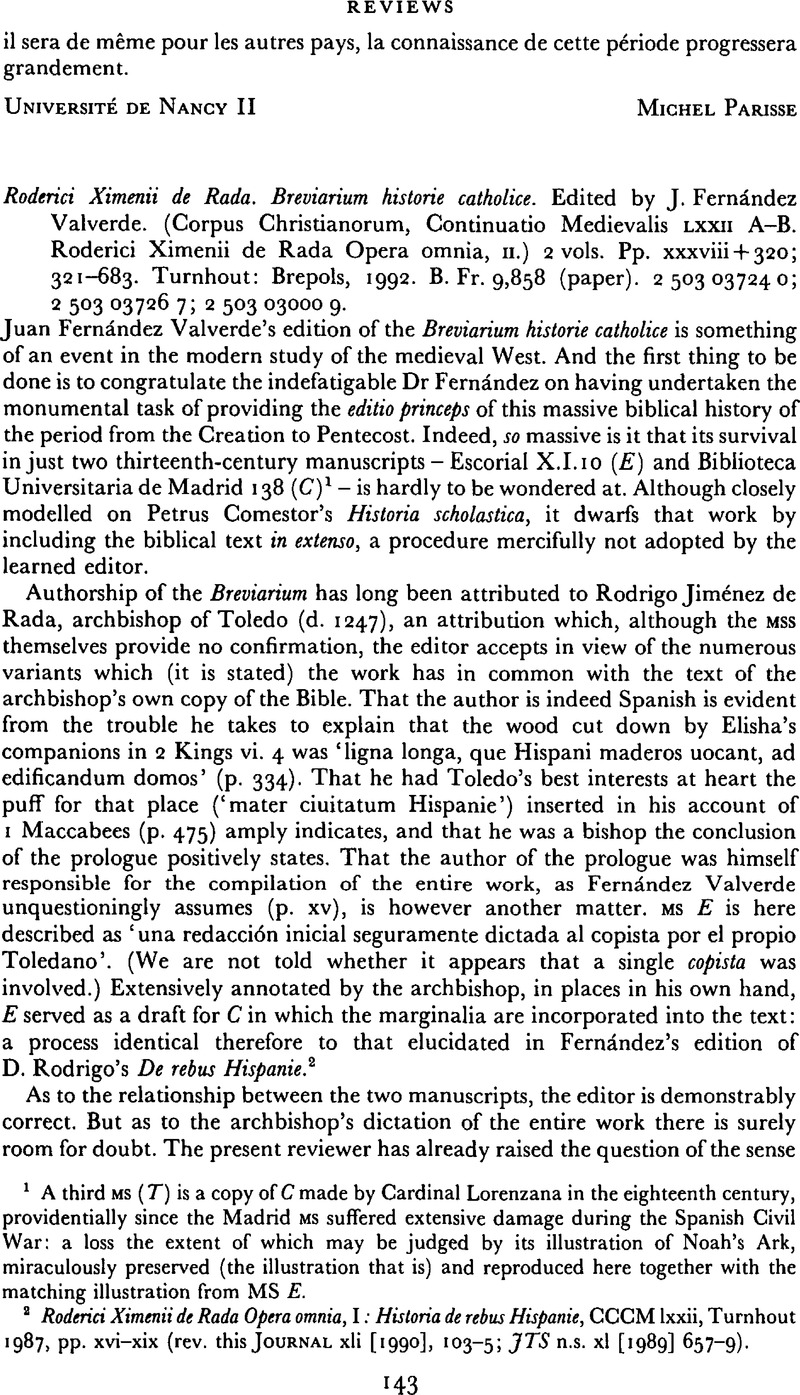No CrossRef data available.
Article contents
Roderici Ximenii de Rada. Breviarium historie catholice. By J. Fernández Valverde. (Corpus Christianorum, Continuatio Medievalis Lxxii A–B. Roderici Ximenii de Rada Opera omnia, ii.) 2 vols. Pp. xxxviii + 320; 321–683. Turnhout: Brepols, 1992. B. Fr. 9,858 (paper). 2 503 03724 0; 2 503 03726 7; 2 503 03000 9.
Published online by Cambridge University Press: 06 February 2009
Abstract

- Type
- Reviews
- Information
- Copyright
- Copyright © Cambridge University Press 1995
References
1 A third MS (T) is a copy of C made by Cardinal Lorenzana in the eighteenth century, providentially since the Madrid MS suffered extensive damage during the Spanish Civil War: a loss the extent of which may be judged by its illustration of Noah's Ark, miraculously preserved (the illustration that is) and reproduced here together with the matching illustration from MS E.
2 Roderici Ximenii de Rada Opera omnia, I : Historia de rebus Hispanie, CCCM lxxii, Turnhout 1987, pp. xvi–xix (rev. this Journal xli [1990], 103–5; JTS n.s. xl [1989] 657–9).Google Scholar
3 History and the historians of medieval Spain, Oxford 1993, 351.Google Scholar
4 ‘lectori supplicans ut in compacte conscriptis correctione et indulgentia condescendat, cum pontificalis occupatio diligenciam uix admittat’ (7. 170–2).
5 MS E originally belonged to the church of Osma where D. Rodrigo was bishop-elect before his translation in 1209 to Toledo, a place with which he had no previous connexion. Moreover, the whole work reeks of the schools. Indeed, the editor interprets the phrase in the prologue, ‘studentis fastidium id requirat’ (5. 101), as an indication that the Breviarium was intended for use at Castile's failed Paris, the schools of Palencia (pp. xxx–xxxvii).E contra, would D. Rodrigo before 1209 have had access to the secretarial assistance that the project necessitated? Then there are the references to Toledo, ‘mater ciuitatum Hispanie’, noted above (which to judge by the editorial apparatus was not an interpolation in MS C), and to the author's ‘other volume’ in gestation (p. 64), noticed by Nicolás Antonio (Biblioteca hispana vetus, Madrid 1788, ii. 51) and interpreted by him as an allusion to the Historia arabum.
6 Cf. Smalley, B., The study of the Bible in the Middle Ages, 2nd edn, Oxford 1952, 252–3. For the significance of strenuitas see Linehan, History and the historians, 298–9, 352–3.Google Scholar
7 Alfonso el Sabio, General estoria, i, Madrid 1930, 5–6; cf. PL cxcviii. 1072–3; Breviarium, 29–30.
8 I. Fernández-Ordóñez, Las Estorias de Alfonso el Sabio, Madrid 1992.
9 ‘Opus… historicum, theologicum, & philosophicum, sanè doctum & eruditum, nec planè inelegans, si captum illius temporis consideremus; quandoque tamen subobscurum adeo ut saepè acumen legentiumeludat’: Antonio, Biblioteca hispana, p. xxxii.
10 Thus at the crowning of Joash (‘dederuntque in manu eius tenendam legem’: 2 Chron. xxiii. ii), the author interposes: ‘librum scilicet legum, in quo docetur qualiter uiuat et quid agat’ (p. 338).The apparent anticipationof Alfonso x’s legislative programme, which came to be known as the Siete partidas, is uncanny, echoing similar sentiments in the General estoria (cf. Linehan, History and the historians, 491), and raising furtherquestions regarding the date of the textus receptus


